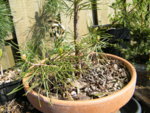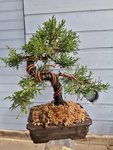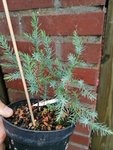Wires_Guy_wires
Imperial Masterpiece
When doing a little hike, I found more people fixing up the woods doing maintenance work. As if we have any nature at all in this country, it's a hoax. We have culture and we have culture. Nature hasn't been seen in hundreds of years.
Anyhow, I have a Spruce and a new Scots pine. Too late in the season actually, parts of the forest floor were frozen. So I have no new spruce and no new scots pine until they show they've survived.
The scots pine has survived a fire, which blazed just 5 metres away from it, turning everything into ash, which somehow made it bud like crazy. 8 terminal buds per branch, on every branch. And backbudding on the trunk.
Picture this.. You've finished an education in plant science, with a specialization in plant science. You know how to handle literature and protocols. You know how to use those data in practical situations. You bring home 40 seeds of a super rare juniper. Then you donate 5 seeds to your father in law and proceed to try and germinate the other 35...
6 weeks later, you get a message with a picture attached "It's alive!" while your super scientific method and controlled variables yield exactly 0 germination. You then switch to the plain 'n dirty in-law-method. And within a week, there's junipers popping up.
I'll be damned!
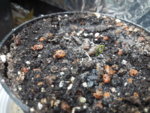
This might very well be the first visually documented case of a germinating Juniperus Turbinata. And I'm going to say it.. If they survive into adulthood, turbinata junipers are the best looking junipers I have ever seen. No Japanese variety can compete with that. I have seen Brian van Fleet's case studies on japanese juniper foliage. Turbinata seems to go the extra mile. Not sure if that's a good thing, but I like it.
Garden peat + sand mixture, with added clay litter and perlite. A single dose of nutrients (accident) and letting the medium dry out between waterings has yielded a 2.8% germination rate. Until now. It might increase over time.
I have 20 or so seeds in the fridge, going for the exact study I'm copying. Which should yield around 5% germination. Hopefully in January.
For now, I need to find out how to keep this seedling alive, indoors..
Another thing. Someone once said: Get a lazy person to do a difficult job, and he will make it easy. Now I don't know who said it, and I'm too lazy to look it up.
Wiring branches horizontally before the big clip'n'grow coming this spring? Too much trouble. Spend 15 cents on paperclips. Good enough for government work.
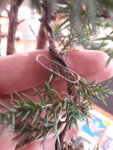
Anyhow, I have a Spruce and a new Scots pine. Too late in the season actually, parts of the forest floor were frozen. So I have no new spruce and no new scots pine until they show they've survived.
The scots pine has survived a fire, which blazed just 5 metres away from it, turning everything into ash, which somehow made it bud like crazy. 8 terminal buds per branch, on every branch. And backbudding on the trunk.
Picture this.. You've finished an education in plant science, with a specialization in plant science. You know how to handle literature and protocols. You know how to use those data in practical situations. You bring home 40 seeds of a super rare juniper. Then you donate 5 seeds to your father in law and proceed to try and germinate the other 35...
6 weeks later, you get a message with a picture attached "It's alive!" while your super scientific method and controlled variables yield exactly 0 germination. You then switch to the plain 'n dirty in-law-method. And within a week, there's junipers popping up.
I'll be damned!

This might very well be the first visually documented case of a germinating Juniperus Turbinata. And I'm going to say it.. If they survive into adulthood, turbinata junipers are the best looking junipers I have ever seen. No Japanese variety can compete with that. I have seen Brian van Fleet's case studies on japanese juniper foliage. Turbinata seems to go the extra mile. Not sure if that's a good thing, but I like it.
Garden peat + sand mixture, with added clay litter and perlite. A single dose of nutrients (accident) and letting the medium dry out between waterings has yielded a 2.8% germination rate. Until now. It might increase over time.
I have 20 or so seeds in the fridge, going for the exact study I'm copying. Which should yield around 5% germination. Hopefully in January.
For now, I need to find out how to keep this seedling alive, indoors..
Another thing. Someone once said: Get a lazy person to do a difficult job, and he will make it easy. Now I don't know who said it, and I'm too lazy to look it up.
Wiring branches horizontally before the big clip'n'grow coming this spring? Too much trouble. Spend 15 cents on paperclips. Good enough for government work.





















